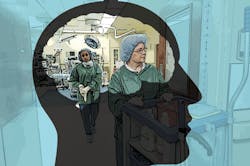Erin Kyle, DNP, RN, CNOR, NEA-BC, Perioperative Practice Specialist, Association of periOperative Registered Nurses (AORN).
OR turnover is an extremely labor-intensive and highly technical task that requires each member of the perioperative team to know what they are doing, be motivated to do their part well, experience few or no interruptions, feel supported in providing a safe environment of care, and to be in seamless communication with every other member of the team. When all of these ingredients of efficient OR turnover come together, the process resembles a well-oiled machine. Any issues in any component of these elements of efficiency can result in the friction that slows down the machine.
Advice to help improve the process:
- Plan well using effective scheduling systems and correct procedure/surgeon preference lists.
- Foster a culture of safety among the interdisciplinary perioperative team.
- Clearly define expectations and roles for OR turnover activities.
- Seek opportunities to ensure each team member is individually proficient for the day’s assignment.
- Seek opportunities to ensure that team members are collectively proficient. We now know through research that team competency may be as important as individual competency.
- Make good professional relationships among team members a priority at all times.
- Provide tools and mechanisms for effective communication to all team members, keeping in mind that verbal communication using devices may require the use of hands which may be busy with other tasks. Think outside the box about how to improve communication. It is the single most important thing to improve to see improvements in perioperative service delivery.
Jason Harbor, Senior Vice President, Product Management, Hospital IQ
Room turnover is an area that is not well understood; neither the steps nor the data is understood well enough to identify what can be improved. It is indicative of the performance of the team, both well performing and poor performing. Part of the issue with turnover time is that it is not actually captured well. As such, hospitals should start by accurately capturing turnover time to better understand the components that matter, to then try to drive change. Once the desired outcome is understood, hospitals can start to drive change to improve it. We are seeing hospitals starting to dedicate resources (e.g., industrial engineers) to focus on understanding the process.
Jeff Robbins, President, CEO, Founder, LiveData, Inc.
To optimize OR utilization, facilities need to map turnovers times to procedure types and scheduled OR rooms. Capturing and analyzing actual turnover times by OR, actual procedure (CPT code), specialty, and even actual provider will provide the operational data to confidently schedule cases to minimize turnover times. The other critical ability is to identify whether the turnover time is mostly room setup or cleanup as different departments may be in charge of those activities.
Justin Rockman, VP of Sales and Business Development, Surgimate
Timing can be a big problem when it comes to room turnover. Practices might not take into account prep time causing case overlaps and room delays. The best thing for a practice to do, short of creating an AI system, is time OR turnover for each type of procedure performed. Creating an average list available for the schedulers will allow them to factor this into OR scheduling.
About the Author

Valerie J. Dimond
Managing Editor
Valerie J. Dimond was previously Managing Editor of Healthcare Purchasing News.

